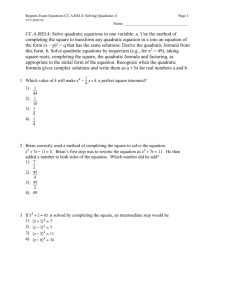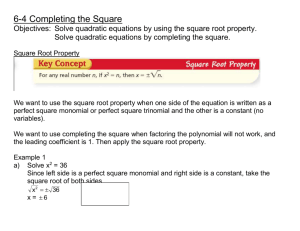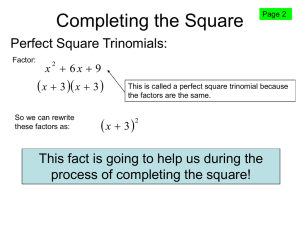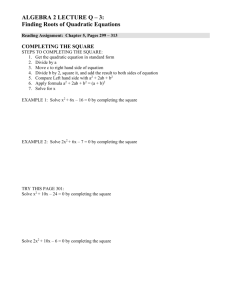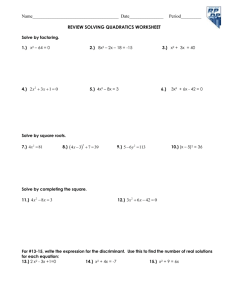DOC - JMap
advertisement
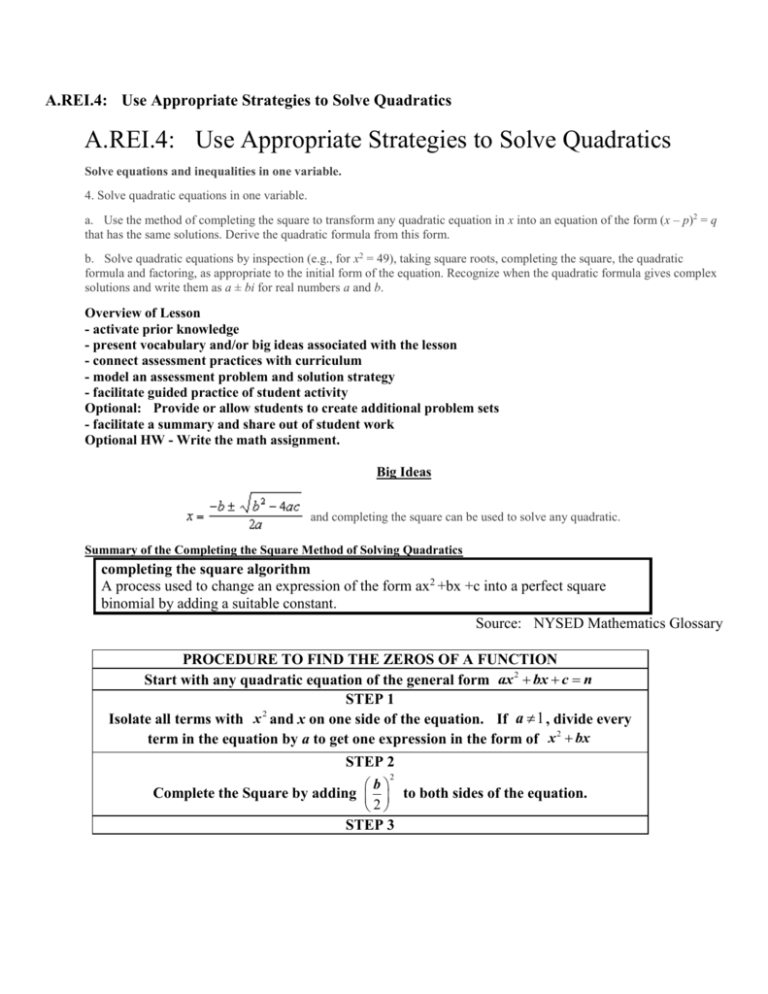
A.REI.4: Use Appropriate Strategies to Solve Quadratics A.REI.4: Use Appropriate Strategies to Solve Quadratics Solve equations and inequalities in one variable. 4. Solve quadratic equations in one variable. a. Use the method of completing the square to transform any quadratic equation in x into an equation of the form (x – p)2 = q that has the same solutions. Derive the quadratic formula from this form. b. Solve quadratic equations by inspection (e.g., for x2 = 49), taking square roots, completing the square, the quadratic formula and factoring, as appropriate to the initial form of the equation. Recognize when the quadratic formula gives complex solutions and write them as a ± bi for real numbers a and b. Overview of Lesson - activate prior knowledge - present vocabulary and/or big ideas associated with the lesson - connect assessment practices with curriculum - model an assessment problem and solution strategy - facilitate guided practice of student activity Optional: Provide or allow students to create additional problem sets - facilitate a summary and share out of student work Optional HW - Write the math assignment. Big Ideas and completing the square can be used to solve any quadratic. Summary of the Completing the Square Method of Solving Quadratics completing the square algorithm A process used to change an expression of the form ax2 +bx +c into a perfect square binomial by adding a suitable constant. Source: NYSED Mathematics Glossary PROCEDURE TO FIND THE ZEROS OF A FUNCTION Start with any quadratic equation of the general form ax 2 bx c n STEP 1 2 Isolate all terms with x and x on one side of the equation. If a 1 , divide every term in the equation by a to get one expression in the form of x 2 bx STEP 2 2 b Complete the Square by adding to both sides of the equation. 2 STEP 3 2 b Factor the side containing x 2 bx into a binomial expression of the form 2 2 b x 2 STEP 4a (solving for roots and zeros only) Take the square root of both sides of the equation and simplify, STEP 4b (solving for maxima and minima only) Multiply both sides of the equation by a. STEP 5 Move all terms to left side of equation. STEP 6 Extract the coordinates of the minima or maxima. EXEMPLARS EXAMPLE A PROCEDURE: Start with any quadratic equation of the general form ax 2 bx c n STEP 1) Isolate all terms with x 2 and x on one side of the equation. If a 1 , divide every term in the equation by a to get one expression in the form of x 2 bx STEP 2) Complete the Square 2 b by adding to 2 both sides of the equation. EXAMPLE B x2 2 x 3 4 5x2 2 x 3 4 5x 2 2 x 1 5x2 2 x 1 5 5 5 2 1 x2 x 5 5 x 2x 1 2 2 b 2, b 2 2 b 1, 1 2 2 2 x 2 2 x 1 1 1 2 x 2 2 x 1 2 2 2 2 2 b 1 b 1 b , , 5 2 5 2 5 2 2 1 1 1 x x 5 5 5 5 2 2 2 STEP 3) Factor the side containing 2 b 2 x bx into a 2 binomial expression 2 b of the form x 2 STEP 4a) Take the square roots of both sides of the equation and simplify. 2 1 1 1 x 5 5 5 x 1 2 1 5 1 x 5 25 25 2 2 2 2 1 6 x 5 25 2 x 1 2 1 6 x 5 25 2 x 1 2 x 1 2 x 1 6 5 5 1 6 1 6 x 5 5 5 PROCEDURE TO FIND MAXIMA OR MINIMA ax 2 bx c n Start with any quadratic equation of the general form ax 2 bx c n a 2 b nc x x STEP 1) a a a 2 Isolate all terms with x and x on one side of the equation. Divide every term in the equation by a to get the left expression into the b form of x 2 x a a 2 b nc b b x x a a a 2a 2a 2 STEP 2) b Complete the Square by adding 2a sides of the equation. b nc b x 2a a 2a 2 STEP 3) EXAMPLE 2 x2 3x 4 5 2 x2 3x 5 4 2 x2 3x 1 2 2 3 1 x x 2 2 2 3 1 x2 x 2 2 2 2 to both 2 x2 3 1 3 3 x 2 2 4 4 2 2 3 1 3 x 4 2 4 2 3 1 9 x 4 2 16 2 3 17 x 4 16 b Factor the side containing x 2 bx into a 2 b binomial expression of the form x 2 2 2 2 2 2 n c b 2 b STEP 4b) a x a 2a 2a a Undo the division by a in STEP 1 by multiplying every term by a. 2 n c b 2 b 0 STEP 5) a x a 2a 2a a Move everything to the left side of the equation. This new form is also referred to as: a x h k 0 2 STEP 6) Write the vertex as an ordered pair. n c b 2 b x h , y k a 2 a a 2a Note: the formula for the axis of symmetry is b 2a 2 3 2 17 2 x 4 1 16 2 3 34 2 x 4 16 2 3 34 2 x 0 4 16 2 3 17 2 x 0 4 8 3 17 x ,y 4 8 3 17 , 4 8 Derivation of the Quadratic Formula: Given Regents Problems 1. The solution of the equation a. b. is c. d. 2. How many real solutions does the equation have? Justify your answer. 3. Which equation has the same solutions as a. b. c. d. 4. Which equation has the same solution as a. c. b. ? ? d. 5. When directed to solve a quadratic equation by completing the square, Sam arrived at the equation Which equation could have been the original equation given to Sam? a. c. b. d. 6. A student is asked to solve the equation . The student's solution to the problem starts as A correct next step in the solution of the problem is a. c. b. d. 7. If a. b. , the roots of the equation are and 25 , only c. d. and 5 , only 8. If the quadratic formula is used to find the roots of the equation a. c. b. d. 9. What are the roots of the equation a. b. 10. What are the solutions to the equation a. b. ? c. d. ? c. d. , the correct roots are . 11. Ryker is given the graph of the function . He wants to find the zeros of the function, but is unable to read them exactly from the graph. Find the zeros in simplest radical form. 12. Solve the equation 13. A student was given the equation written is shown below. algebraically for x. to solve by completing the square. The first step that was The next step in the student’s process was trinomial. Explain how the value of c is determined. 14. Write an equation that defines . as a trinomial where . State the value of c that creates a perfect square . Solve for x when A.REI.4: Use Appropriate Strategies to Solve Quadratics Answer Section 1. ANS: C Strategy 1: Solve using root operations. Strategy 2. Solve using the quadratic equation. PTS: 2 REF: 081523ai KEY: completing the square 2. ANS: No Real Solutions Strategy 1. Evaluate the discriminant NAT: A.REI.4 for , TOP: Solving Quadratics , and . Because the value of the discriminant is negative, there are no real solutions. Strategy 2. Input the equation in a graphing calculator and count the x-intercepts. The graph does not intercept the x-axis, so there are no real solutions. PTS: 2 REF: 081529ai NAT: A.REI.4 TOP: Using the Discriminant 3. ANS: D Strategy: Use the distributive property to expand each answer choice, the compare the expanded trinomial to the given equation . Equivalent equations expressed in different terms will have the same solutions. a. c. b. d. PTS: 2 REF: 011517a1 NAT: A.REI.4a TOP: Solving Quadratics KEY: completing the square 4. ANS: B Strategy: Use the distributive property to expand each answer choice, the compare the expanded trinomial to the given equation . Equivalent equations expressed in different terms will have the same solutions. a. c. b. PTS: 2 REF: 061408a1 KEY: completing the square 5. ANS: D Strategy: Work backwards from the term d. NAT: A.REI.4a TOP: Solving Quadratics to find equations where , then complete the square to choose. STEP 1. Eliminate equations where Eliminate answer choices a and b. STEP 2. Complete the square for answer choice c. Eliminate answer choice c. DIMS? Does answer choice d make sense? Yes. Prove by completing the square. PTS: 2 REF: 061518AI NAT: A.REI.4a TOP: Solving Quadratics KEY: completing the square 6. ANS: A Strategy: The next step should be to take the square roots of both expressions. The correct answer choice is a. PTS: 2 REF: 061521AI KEY: completing the square 7. ANS: C Strategy: Solve using root operations. NAT: A.REI.4a TOP: Solving Quadratics Answer choice c is correct. PTS: 2 REF: 081403a1 NAT: A.REI.4b TOP: Solving Quadratics KEY: taking square roots 8. ANS: A Strategy: Use the quadratic equation to solve , where , , and . Answer choice a is correct. PTS: 2 REF: fall1302a1 NAT: A.REI.4b TOP: Solving Quadratics KEY: quadratic formula 9. ANS: B Strategy: Use the quadratic equation to solve , where , , and Answer choice b is correct. PTS: 2 REF: 061410a1 NAT: A.REI.4b TOP: Solving Quadratics KEY: quadratic formula 10. ANS: A Strategy: Use the quadratic equation to solve , where , , and . . Answer choice a is correct. PTS: 2 REF: 061523AI KEY: completing the square 11. ANS: x 2 2 NAT: A.REI.4b Strategy: Use root operations to solve for x in the equeation PTS: 2 REF: fall1306a1 NAT: A.REI.4b KEY: taking square roots 12. ANS: Strategy 1: Solve using factoring by grouping. TOP: Solving Quadratics . TOP: Solving Quadratics Strategy 2: Solve by completing the square. Strategy 3. Solve using the quadratic formula, where , , and . PTS: 2 KEY: factoring 13. ANS: REF: 011529a1 NAT: A.REI.4b The value of c that creates a perfect square trinomial is TOP: Solving Quadratics , which is equal to 9. The value of c is determined by taking half the value of b, when , and squaring it. In this problem, . PTS: 2 REF: 081432a1 KEY: completing the square 14. ANS: and Strategy: Transform the expression and solve it. STEP 1. Transform NAT: A.REI.4b TOP: Solving Quadratics to a trinomial, then set the expression equal to 0 into a trinomial. STEP 2. Set the trinomial expression equal to 0 and solve. , so PTS: 4 KEY: factoring REF: 061433a1 NAT: A.REI.4b TOP: Solving Quadratics
